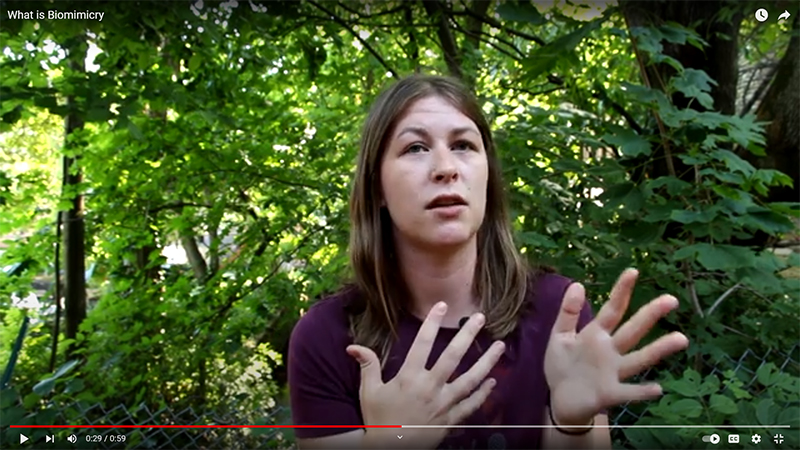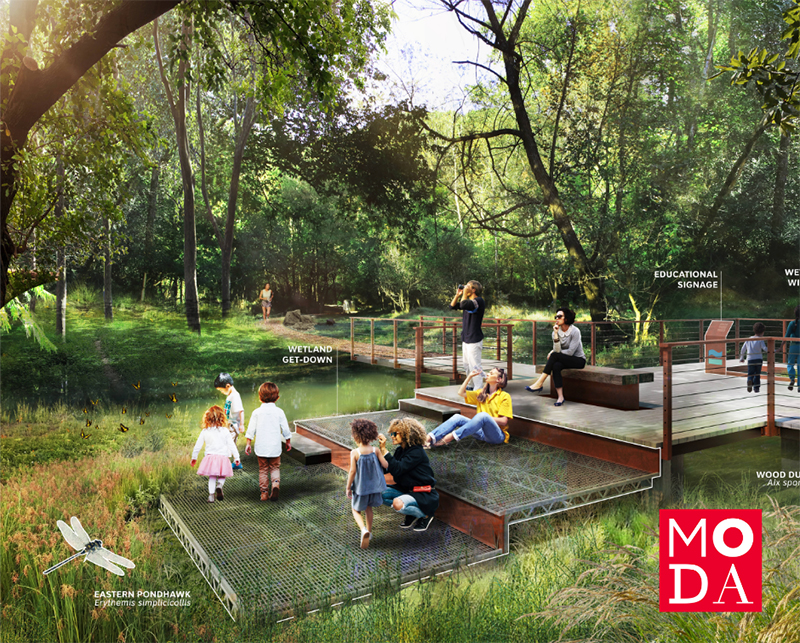Biohabitats Projects, Places & People
By Amy Nelson
Projects
Dam Removal Opens Miles of Habitat for Migratory Fish
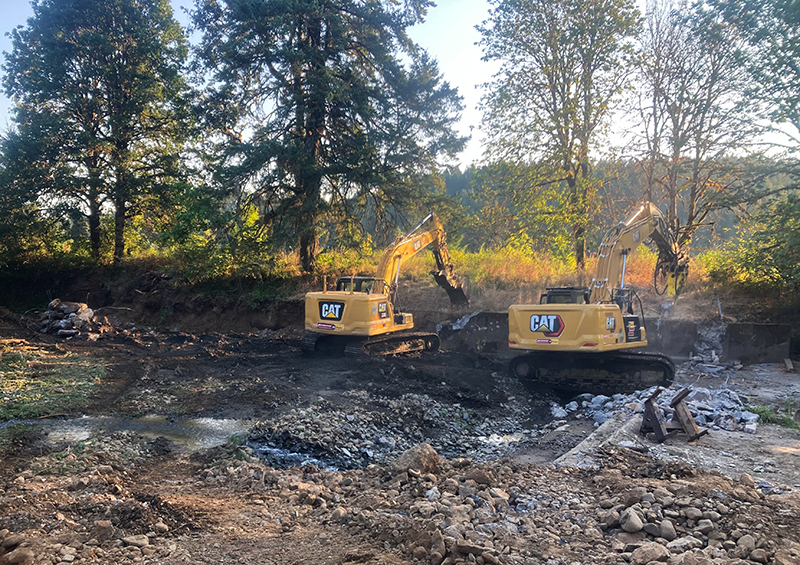
Gales Creek offers some of the best fish habitat in Washington County, Oregon. Thirteen miles upstream from its confluence with the Tualatin River, however, that habitat is impacted by an obsolete dam that was constructed in the 1930s. The 30-foot thick, 100-foot wide dam was originally built to create an area for water recreation. Though humans no longer swim at the site, many species of migratory fish do, and the dam was impeding access to miles of habitat for juvenile and adult mountain whitefish, mountain sucker, largescale sucker, coho salmon, and the endangered Pacific lamprey and winter steelhead. We’re thrilled to be helping our partners at Clean Water Services remove the dam and restore impacted areas to improve habitat. Before removing the concrete confines of the dam, our team temporarily diverted the creek, salvaged fish, and safely transported the fish downstream. We promise to keep you posted as free flow is restored to Gales Creek, so keep an eye on our social media platforms! For information about this project, please contact Matt Koozer.
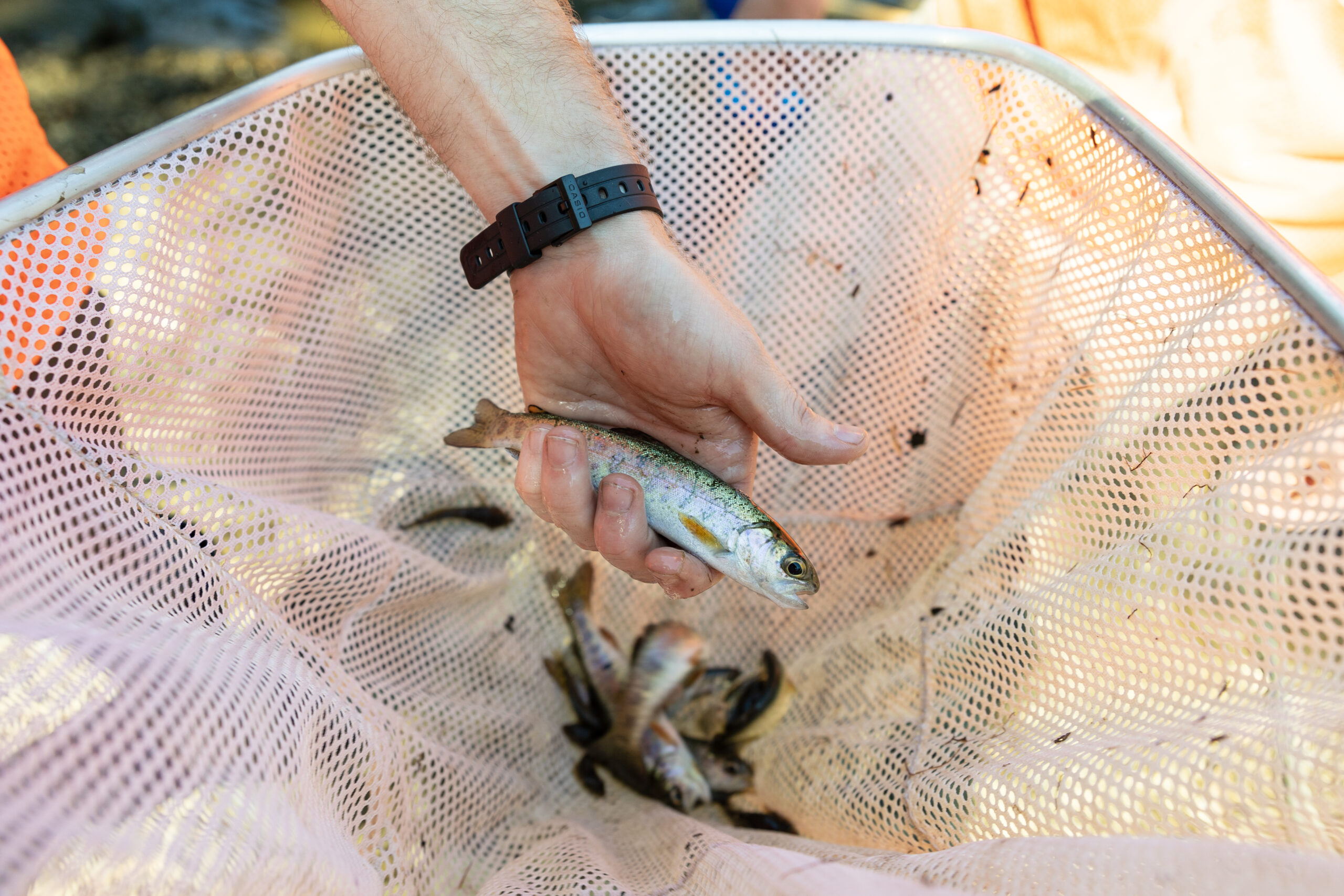
Once an Expanse of Wet Sand, Springbrook Gardens Park Comes to Verdant, Vibrant Life
In 2014, the City of Mentor, Ohio acquired a 56-acre property with the intent of transforming it into passive, recreational park known as Springbrook Gardens Park. The City also received a grant from the Ohio EPA to restore a degraded, channelized ditch that flowed through the park and directly into Mentor Marsh, a State Nature Preserve and National Natural Landmark. Two years ago, after collaborating with the City, Chagrin River Watershed Partners and the Lake County Soil and Water Conservation District on a restoration design, we completed construction of the project with our partners, Meadville Land Service. We visited the site, earlier this month and we’re delighted to report that the vegetation has really taken off in what is becoming a biodiverse, ecologically functioning, and downright beautiful stream and wetland complex. For more information about this project, please contact Kevin Grieser.
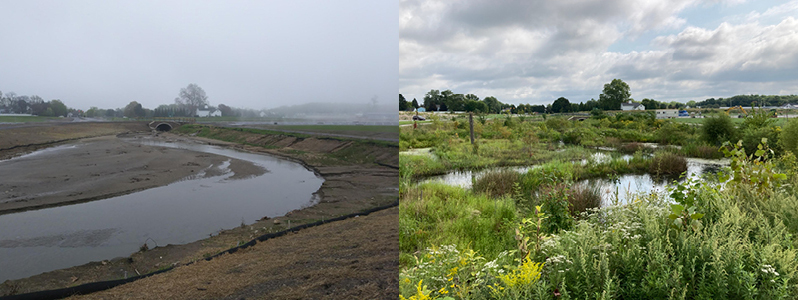
Green Infrastructure Parklet Forms Link in Mill River Trail
Connecticut’s Mill River, which flows into New Haven Harbor, has long been associated with industry. Over the last several decades, it had suffered degradation from stormwater runoff, agriculture, combined sewer overflows, illicit discharges, and other problems related to development and land use activities. In an effort to reclaim and celebrate the river as a recreational and wildlife habitat asset, the City of New Haven created a plan to establish a riverside trail that would not only link 300+ acres of green space but reconnect people to water and nature. At the same time, Save the Sound produced the Mill River Watershed Based Plan, which called for the implementation of grey and green infrastructure to help improve water quality in the river.
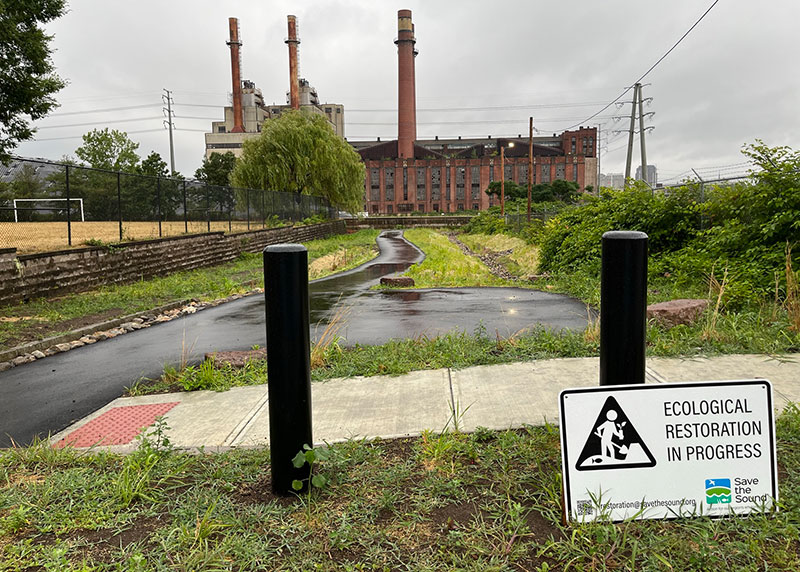
Save the Sound turned to Biohabitats for help in transforming one site along the new Mill River Trail—an unused, 12,000-square-foot section of dead-end roadway that was frequently flooded—into a parklet that uses green infrastructure to capture and treat runoff while enhancing the site’s beauty and ecological function. Construction of the site, which includes bioretention facilities featuring a diverse array of native plants, wrapped earlier this summer. We’re pleased to report that at our last visit, the parklet was not only handling stormwater as designed, but it was also beginning to receive increased volume foot, bike, and wing travel! For more information about this project, please contact Kevin Dahms.
Talk About Ecological Uplift!
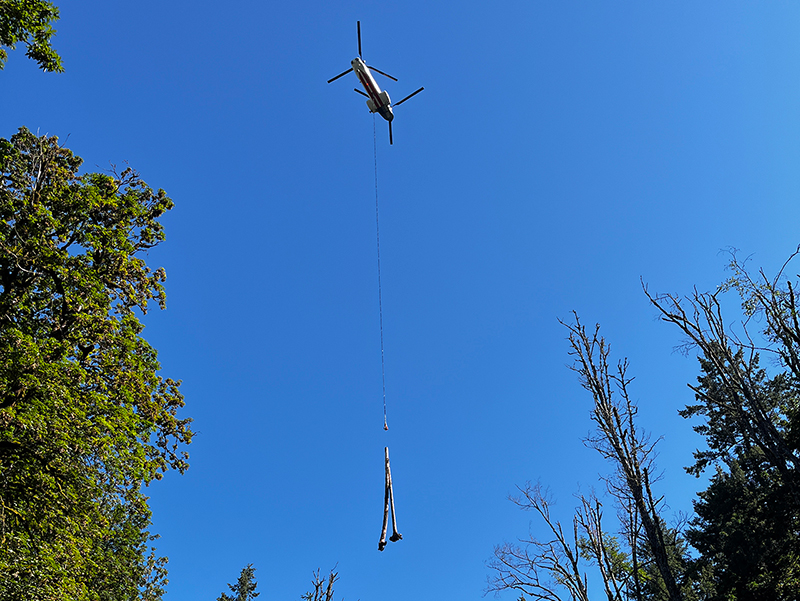
Earlier this summer, we helped Metro, the regional government for the Oregon portion of the Portland metropolitan area, restore over one mile of fish habitat to Newell and Abernethy Creeks, tributaries to the Willamette River. The restoration design, which was crafted by Inter-Fluve, included the construction of instream habitat structures and required the careful placement of salvaged trees, brush piles, and more than 200 logs. And when we say careful, we mean it. With the Abernethy Creek site located in a very deep ravine, much of the wood had to be transported via helicopter.
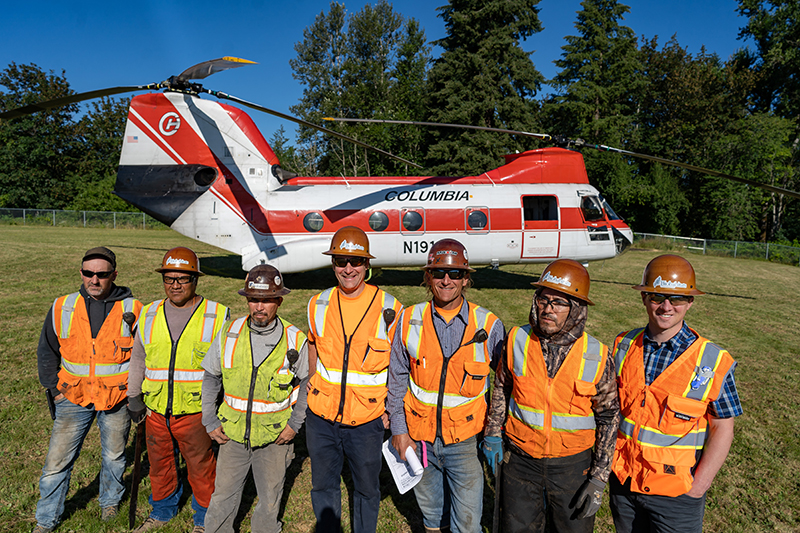
Thankfully, we have great partners in Columbia Helicopter! After salvaging fish, dewatering the channel, and moving more than 800 cubic yards of soil to create deep pools, we collaborated with the Columbia Helicopter team to ensure that each item was safely lifted, carried, and placed in the appropriate spot. The newly installed structures will provide habitat for a variety of species, including federally listed coho salmon, steelhead, and Pacific lamprey. For more information about this project, contact Matt Koozer.
Restored Freshwater Wetlands Greening Up in New Jersey
Thanks to the Bergen County Department of Parks, the Teaneck Creek Conservancy, and dedicated community members, a once degraded site in Teaneck, New Jersey is transforming into a beautiful, biodiverse, ecologically functioning public park. Originally dominated by freshwater tidal wetlands, the site’s hydrology had been altered by the installation of a downstream tide gate. Two large stormwater outfalls at the site discharge runoff, which has carved eroded gullies so severe that one has been dubbed “Stormwater Canyon” by locals.
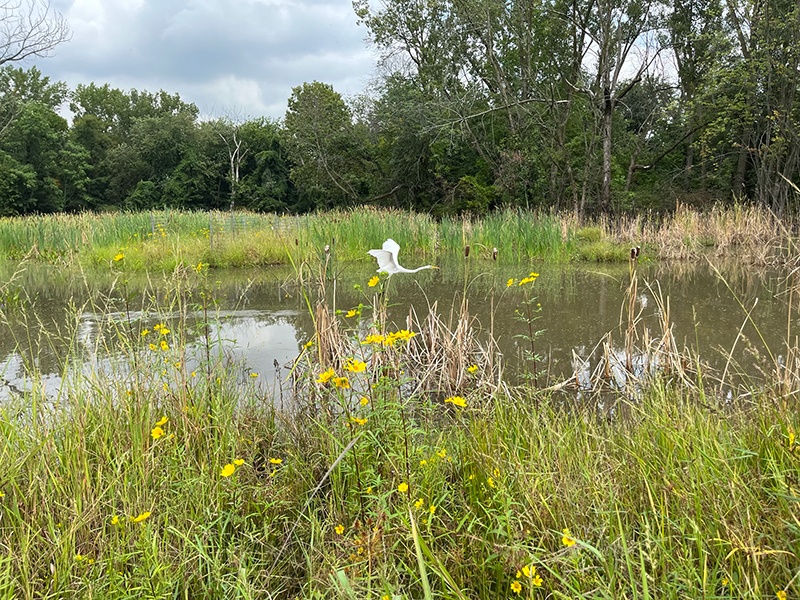
Building upon a concept created by Rutgers’ Center for Urban Environmental Sustainability, Biohabitats developed a design that restores wetlands within the creek’s floodplain and mitigates the erosive forces of stormwater through regenerative design. Earthwork, conducted by SumCo Eco Contracting and managed by SiteWorks, wrapped last fall and plants were installed this spring. The native plantings are taking root, and we look forward to the reopening of Teaneck Creek Park soon. For more information about this project, please contact Kevin Dahms.
Bosque: A Welcoming Wetland in New Mexico
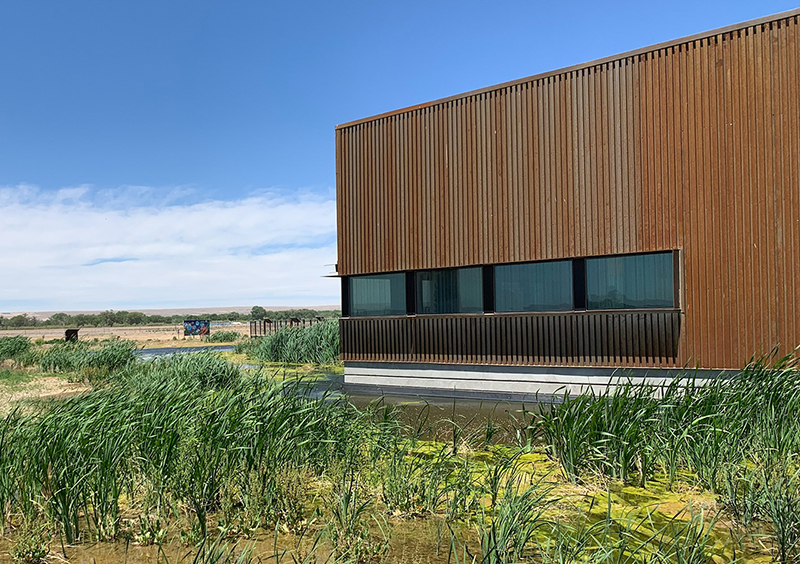
For many birds, mammals, insects, spiders, and crustaceans native to New Mexico, the cottonwood forest bordering the Rio Grande is familiar and important habitat. For many humans, however, this unique riparian ecosystem—known as the Bosque (“forest” in Spanish)—may not be as familiar. That is all about to change now that the new, LEED-certified visitor center at the Valle de Oro National Wildlife Refuge has officially opened its doors. The center, which was designed by the joint venture CF Padilla-Brycon in collaboration with Formative Architecture and Weddell Gilmore, features unique opportunities for people to experience nature in a rather urban area. This includes a half-acre rain and groundwater-fed wetland feature designed by Biohabitats! Designed to mimic a natural Rio Grande Bosque wetland, the feature’s variable water depths support a variety of native plants, and thus provide diverse habitat.
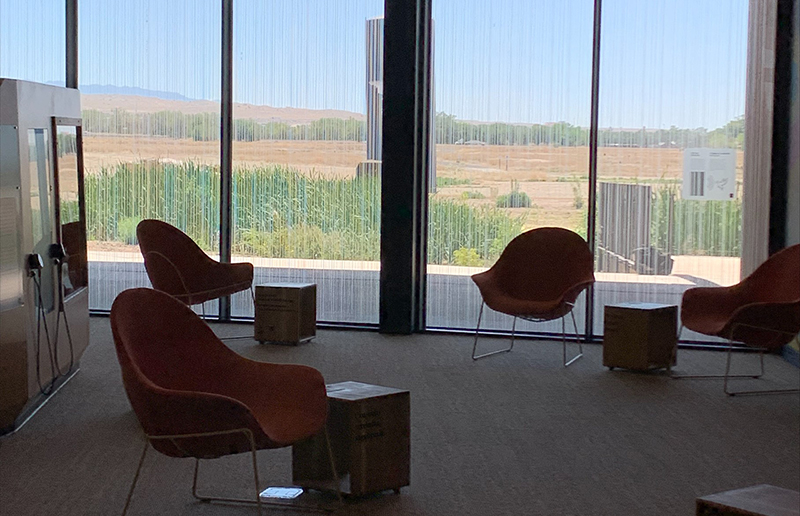
Located just outside of the visitor center, the feature allows visitors to experience a southwestern riverine wetland up close, through windows, and from overlooks and paths. We also designed an onsite system that treats wastewater from the Visitor Center and returns it to recharge groundwater. For more information about this project, please contact Erin English.
Degraded Agricultural Site Beginning to Demonstrate Regenerative Land Use
Over the summer Biohabitats worked with The Nature Conservancy and project partners, ERC, to construct the Jacoby Branch Mitigation Project in Yellow Springs, Ohio. The project, which offsets impacts to the Little Miami River watershed, is located on the site Ohio’s first Center for Regenerative Agriculture, known as Agraria. The stream and its tributaries were ditched and straightened long ago and much of the surrounding fields were tile drained, which caused wetlands to disappear.
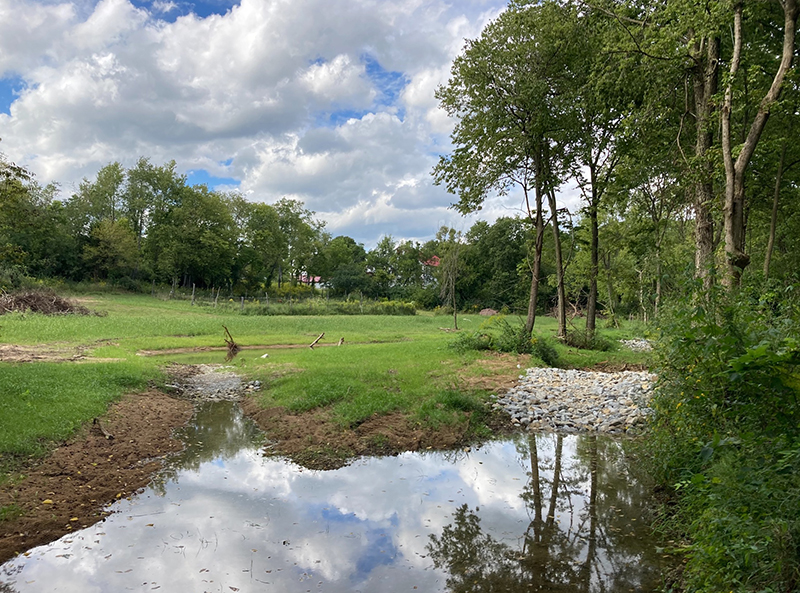
Now nearly 50% complete, the integrated stream and wetland restoration project is already helping to retain water longer on the landscape. These changes are restoring ecological processes to the landscape and restoring habitat that had been lost. We look forward to completing construction and watching this site continue to come to life and support Agraria’s educational and research programs related to regenerative land use. For more information about this project, please contact Suzanne Hoehne.
Spared from Wildfire, Coyote Creek State Park Gaining New Amenities
Nestled in the foothills of the Sangre de Cristo Mountains along the meandering Rio Coyote, the 462-acre Coyote Creek State Park is known for its abundant wildflowers and beautiful fall foliage, and it draws many visitors. The creek itself is the surrounding agricultural community’s lifeblood, as a network of historic irrigation ditches (acequias) carry its water to their fields. One acequia runs through the park’s Encino Campground. Increased demand for outdoor recreation prompted the New Mexico Energy, Minerals and Natural Resources Department (EMNRD) State Parks Division to plan new park amenities.
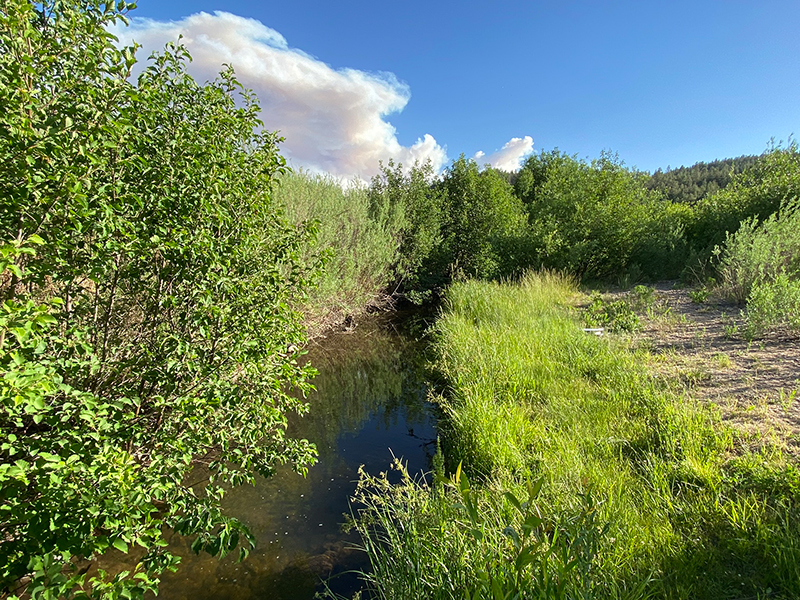
To help ensure that future plans would protect the site’s ecological features, including wetlands and habitat for two endangered species (New Mexico meadow jumping mouse and southwestern willow flycatcher), EMNRD turned to Biohabitats. After conducting habitat assessments and delineating wetlands amidst the park’s stunning landscape, we helped prepare NEPA documentation, map the site with overlays for new buildings, circulation, and infrastructure, and consult with the Park Service, Forest Service and U.S. Army Corps of Engineers. Although the park was evacuated during New Mexico’s historic Hermits Peak/Calf Canyon Fires this spring, it was thankfully spared, and construction of the new amenities has begun. For more information about this project, contact Susan Sherrod.
From Tilling to Tutelage: Former Farmland Transforming into Living Laboratory
With funding from Ohio’s H2Ohio Program, the Black Swamp Conservancy and the Otsego School District are transforming a previously farmed site in Wood County, Ohio that was threatened by development into a living laboratory where students can study a variety of ecosystems and landscapes. We are honored to be helping these partners create the living laboratory by restoring ecological function to the 16-acre site, which is located across the street from Otsego K-12 schools. The land, which was transferred to the Conservancy by the owning families, is bound on the northeast by the main branch of Tontogany Creek, and ultimately drains to the Maumee River and thus Lake Erie.
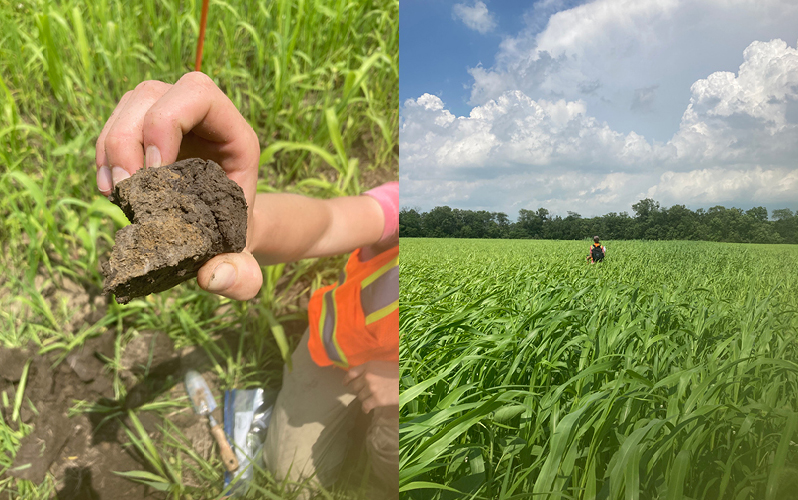
With survey nearing completion, we’re about to begin collaborating on the living laboratory’s design, which will include restored wetlands and riparian habitats, a food forest, and new access to the creek. In addition to providing students with hands-on educational opportunities, such as sampling fish and macroinvertebrates, exploring wetland, riparian, and meadow habitats, learning about the relationship between agriculture and ecology, and creating nature-inspired art, the lab will reduce runoff and sedimentation, increase nutrient uptake, and enhance wildlife habitat. We’ll be doing a design charette with students next month and we can’t wait see them out there using and enjoying their living laboratory in the future! For more information about this project, please contact Kevin Grieser.
Places
Nature at the Root of New Solutions
Last month, Biohabitats Biomimicry Fellow, Elena Stachew, traveled to Lyon, France with her colleague and fellow University of Akron Biomimicry PhD candidate, Thibaut Houette to attend the 10th International Plant Biomechanics Conference. Elena and Thibaut were there to present their work studying and creating models of root systems for potential use in ecological restoration and architecture. Their talk, “A Parametric Process for Root System Architecture Analysis: A Case Study Analyzing Topology and Morphological Traits Across Tree Species Imaged in the Field” allowed participant to tap into the promise of biomimicry. What exactly is biomimicry, and how is Elena applying it to ecological restoration? Learn more about Elena’s work in the Rhizome blog!
Sharing Restoration Construction Knowledge with Tomorrow’s Designers
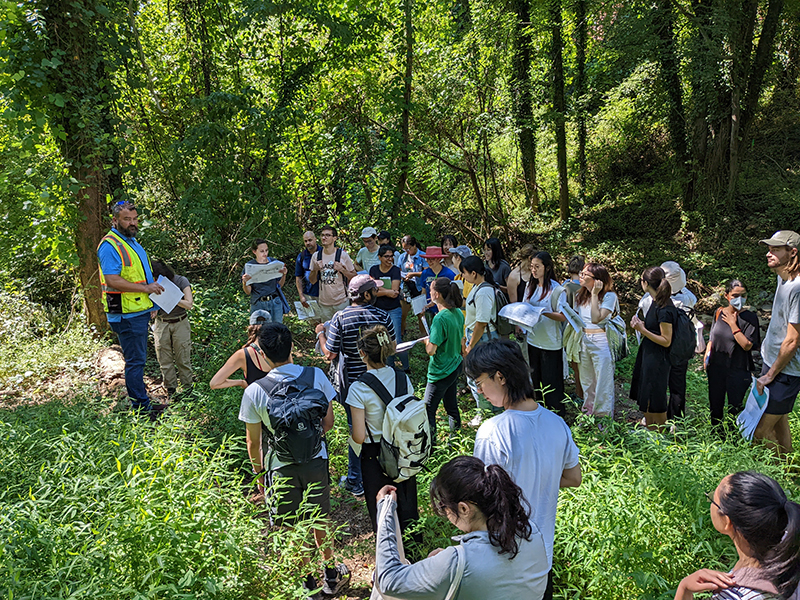
Biohabitats Construction Coordinator, Jim Favret recently took time from his busy project schedule to teach students in an Ecology and Technology (ETIII) class in the University of Virginia’s School of Architecture about ways to better translate the intent of restoration design into construction documents. Fortunately, the University campus has a perfect case study: a recently restored reach of the headwaters of Meadow Creek. Biohabitats designed the restoration and provided oversight of the construction, which was done by Faulconer Construction and Meadville Land Service in 2021. With plan sets in hand, the students had the opportunity to walk the site, learn how design drawings translate into “contractor language,” and better understand how to implement and manage restoration construction.
Strong Stewardship in Cuyahoga Falls
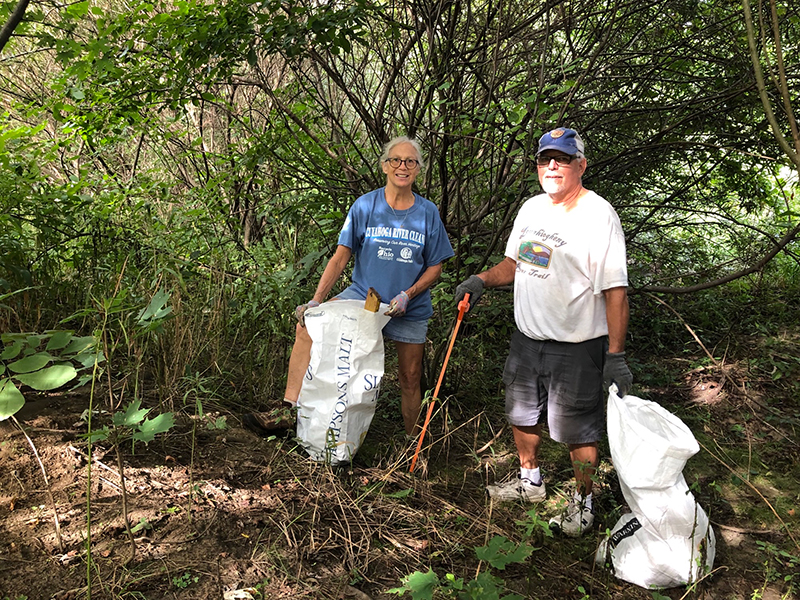
Earlier this month, 75 volunteers joined Biohabitats, the City of Cuyahoga Falls, and Summit Soil and Water Conservation District as a part of the Fall River Cleanup Series put together by The City of Cuyahoga Falls to learn about the stream restoration of Kelsey Creek, clean up litter, and remove tree cages 10 years after the conclusion of the restoration. 500 pounds of debris were collected, 100 cages removed and recycled within the City with volunteers sharing stories and memories of the park for a successful cleanup on a beautiful early fall day.
Revealing the RiverLands
The Chattahoochee River is a shared historic, economic, cultural, and ecological resource of extraordinary value for Metro Atlanta and the state of Georgia, but the lack of access to the waterway has meant that it has also been an undervalued amenity with unrealized opportunity for the region. With the Chattahoochee RiverLands Vision, released in 2020, this is about to change. A network of greenways, blueways, parks, and destinations will bring people to the water’s edge, promote stewardship and conservation of the river, and reveal the subtle magic of the Chattahoochee to all. Anyone interested in learning more about this vision and helping to bring it to life can join a conversation with four members of the project team: SCAPE’s Gena Wirth, Walt Ray with the Trust for Public Land, Dr. Na’Taki Osborne Jelks of Spelman College, and our very own Keith Bowers. The conversation, which is being put on by the Museum of Deign Atlanta (MODA) will take place in Georgia Tech’s gorgeous (and we’re not just saying that because we helped design the water infrastructure!) Kendeda Building for Innovative Sustainable Design. This event is free, but space is limited, so please reserve your place in advance.
Upcoming Presentations and Events
September 23: Biohabitats Senior Engineer Chris Streb and Ecologist, Tanaira Cullens, will be among the experts discussing the health and future of waterways within Baltimore’s 40-square-mile Jones Falls watershed at the Beyond the Jones Falls Conference. Tanaira will facilitate a panel about the science driving policy and practices and Chris will participate in a panel on Engineering Green. Tickets are still available!
October 12-13: The biennial Pennsylvania Stormwater Symposium takes place in Villanova. Water Resources Engineer, Brett Long, will present “Partnership for Wissahickon Floodplain Reconnection,” giving symposium attendees the chance to learn about the award-winning regeneration of a severely degraded creek flowing through a utility corridor.
October 12-14: This year’s annual gathering of the Mid-Atlantic Chapter of the Society for Ecological Restoration will occur in Annapolis, Maryland. If you plan to attend, be sure to join us on one of three field trips to nearby Biohabitats project sites.
October 11-13: The theme for this year’s Sustaining Colorado Watersheds Conference, which will take place in Avon, CO, is “Bridging Connections: Learning from the Past, Investing in the Future.” If you are attending the event, be sure to bridge a connection with Biohabitats Western Bioregions leader Claudia Browne, and Principal Engineer, Mike Lighthiser.
October 19-20: The South Carolina Water Resources Conference will be held in Columbia, South Carolina. Attendees will not want to miss Senior Water Resources Engineer, Meghan Gloyd’s presentation, “Identifying Nature Based Solutions to Improve Flood Storage and Resiliency in the Church Creek Drainage Basin” on the afternoon of October 19.
October 25-27: The National Adaptation Forum will take place in Baltimore, Maryland. The Forum gathers the adaptation community to foster knowledge exchange, innovation, and mutual support for a better tomorrow. If you are plan to be there, keep an eye out for Biohabitats senior engineer Pete Munoz and Western Bioregions Operations leader, Claudia Browne, who are attending.
November 11-14: The American Society of Landscape Architects will hold its annual meeting in San Francisco. On November 13, Biohabitats Founder and President Keith Bowers will join Kelly A. Farrell of Sasaki and Tim Nuttle of Oikos Ecology to present a 75-minute educational session on “Confronting the Biodiversity Crisis Through Landscape Architecture.” Conference participants will learn a lot from these three experts, including how to collaborate with ecologists, incorporate biodiversity protection and restoration into project site designs, planting practices, and construction processes.
December 4-8: Restore America’s Estuaries will host the 2022 Coastal & Estuarine Summit in New Orleans. Biohabitats Senior Ecologist Joe Berg will present a talk on Coastal Plain stream, floodplain, and wetland restoration using wood structures made with material harvested from the project site and he will present poster on the use of nature-based restoration to initiate system change and improve resiliency to water level fluctuation.
People
Meet our Newest Team Members!
Several people have joined the Biohabitats family over the past few months. One has a fondness for ska-punk music. One is a hunter… of vintage clothing. One uses free time to tinker with “pee-ponics.” Can you guess which one created an ice cream trail map that helps people find the best scoops in Connecticut? Check out the Rhizome blog to see who it is and learn more about our newest team members.
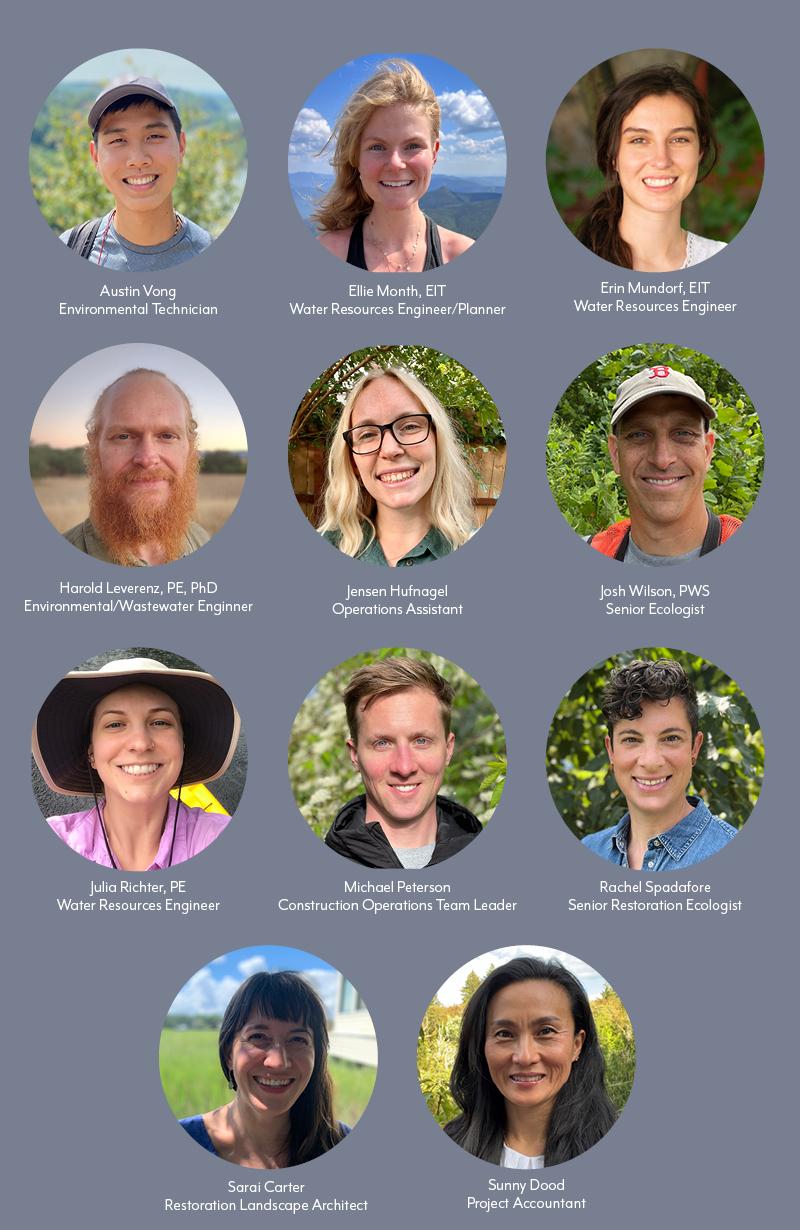
Looking to the Future: Biohabitats Interns
This summer, we were honored to host two Morgan State University graduate students —Jonathan Melgarejo, who is pursuing a master’s degree in City and Regional Planning, and Kayla Goldstein, who is pursuing a master’s degree in Landscape Architecture—as summer interns. Throughout the summer, Jonathan and Kayla provided valuable support on a variety of projects in the Chesapeake/Delaware Bays bioregion, monitoring wetland soils and vegetation, inspecting stormwater BMPs, assisting with graphics, and more. They both shared their thoughts on the value and impact of their summer internships on the Rhizome blog. They also taught us a thing or two. “One of the things I was reminded of while working with Jonathan and Kayla is to continue to “think big,” said Ecologist, Tanaira Cullens, who coordinated this year’s internship program. “Both of them had what seemed like lofty ideas for their final projects, but there is a way for both to come to fruition and I think that’s pretty cool.”
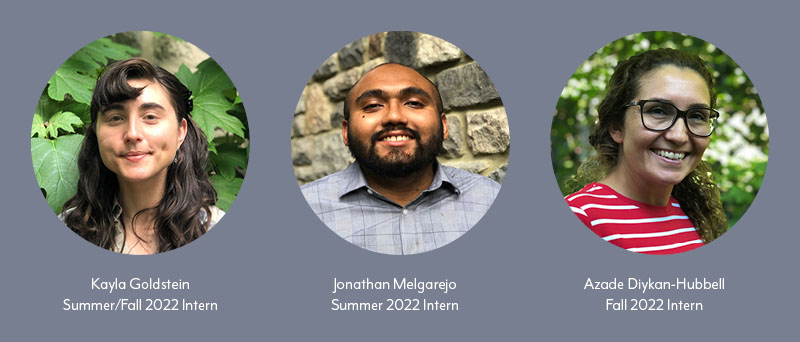
Kayla will continue her internship this fall, and she will be joined by Azade Diykan-Hubbell. Azade, who holds a bachelor’s degree in geography from Istanbul University, is in the third year of her Master’s program at Morgan, and we’re delighted to welcome her to Biohabitats. Having witnessed the loss of so many green spaces in Istanbul, her home city, Azade looks forward to learning more about green infrastructure and other strategies for improving urban ecology and linking people with nature in public places.
Hats Off to these Achievers!
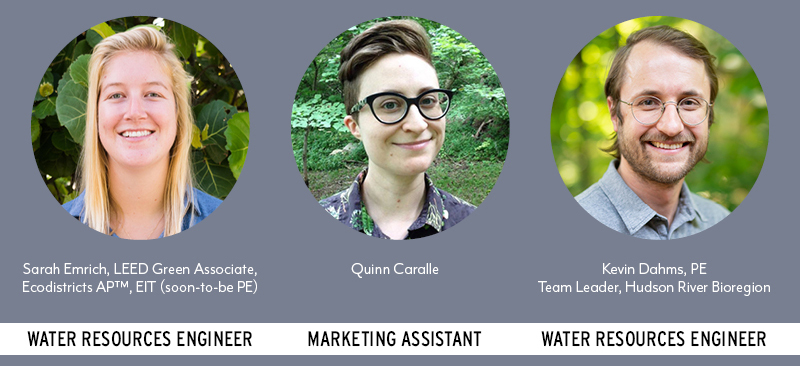
Congratulations are in order for three of our team members. Sarah Emrich passed her P.E. exam, Quinn Caralle was promoted to Marketing Assistant, and Kevin Dahms now leads the Hudson River Bioregion office.
